Free agency opened on July 1, and with that came the possibility of offer sheets. But despite swirling rumors and threats of an offer targeted at Maple Leafs restricted free agent, Mitch Marner, nothing materialized. Instead, we saw the Montreal Canadiens take a swing at Carolina Hurricanes’ No. 1 centre, Sebastian Aho, who signed their five-year, $42.47 million sheet. As we all now know, the Hurricanes matched to retain the Finnish forward. But what does all of this mean for Toronto, the centre of the hockey universe?
All jokes aside, the league’s first offer sheet since 2013 has real implications for Marner and the Maple Leafs. In the middle of what appears to be a lengthy and difficult negotiation process, anything in the form of a comparable contract is useful information. And luckily for the Maple Leafs, the Aho deal seemed to tip the scales in their favour.
Aho Contract Sets the Standard
Despite his rumored contract demands, the reality is that Marner does not have the ability to decide his own comparables or write his own paycheck. Well, he can try, but it won’t get him very far in negotiations. Even Auston Matthews, who was seemingly handed a blank check, had to fall below the ceiling set by Connor McDavid and the 16.7 percent of the team’s salary cap his contract represented. And as discussed ad nauseam, Marner’s ceiling is certainly lower than that, as he is a clear tier below Matthews. The newly-inked Aho deal makes that even more apparent.
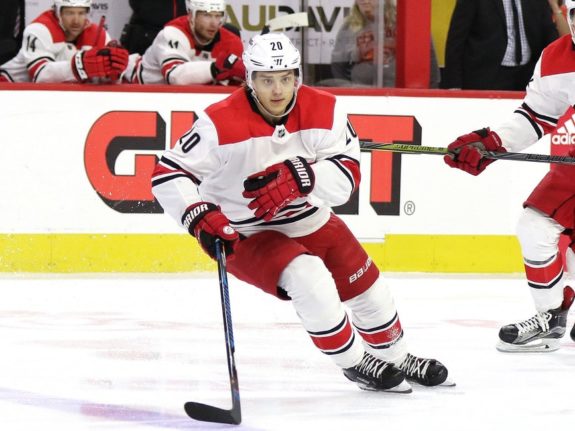
Like Matthews, Aho plays centre – the more valuable position. He’s also a point-per-game player and a bonafide 30-goal scorer (30 this season, and 29 in 78 games the season prior). And unlike Marner, Aho drives play and carries his own line. Aho’s expected goals (Off_xG) and offensive possession (Off_CF) marks are among the best in the league, while Marner, in comparison, was just slightly above average in both areas.
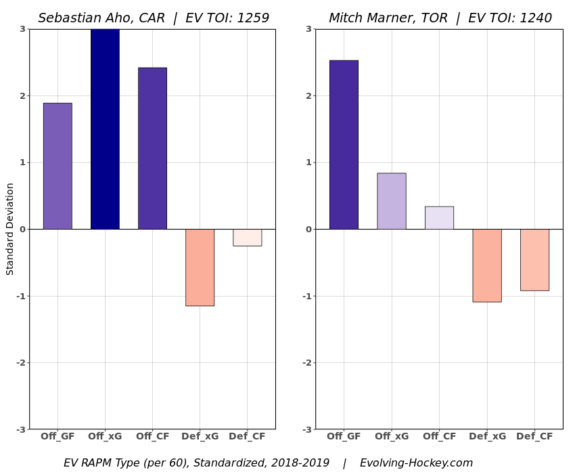
In fact, Aho’s on-ice impact looks a lot like a certain top-five centreman that plays with Marner.
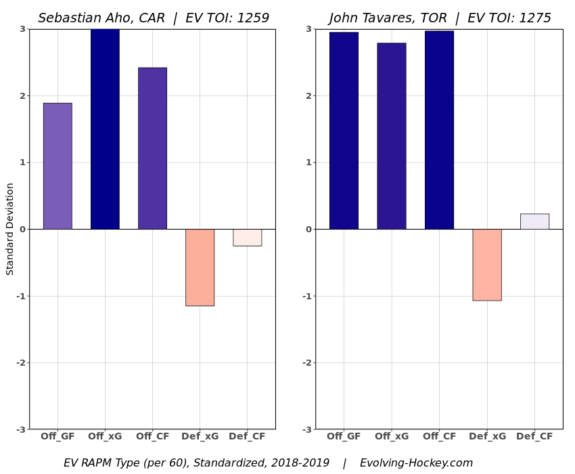
But even while finishing first in team scoring, 11th amongst centres, and 21st league-wide, Aho signed for a very reasonable $8.454 million per season. As it now stands, that will make him the 25th highest-paid player in the National Hockey League this season – arguably a bargain for the scoring prowess and all-around game that Aho brings to the Hurricanes. And when you consider the fact that Marner may be asking for Matthews money, Aho’s deal looks like a steal in comparison.
That raises an obvious question: Is Aho’s contract a steal, or is Marner’s ask simply ridiculous? Based on the market, it’s looking more like the latter.
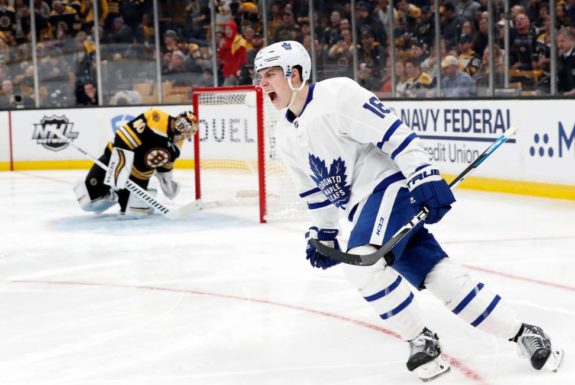
In line with Aho and his reasonable deal, Timo Meier of the San Jose Sharks signed for four years at a cap hit of $6 million. While not viewed as one of the upper echelon RFAs of the summer, Meier scored 30 goals and 66 points this season – nothing to scoff at for a 22-year old in his second full NHL season. Neither of these players signed for anything close to the double-digit mark that Marner is apparently seeking, and that should send a message to the Markham-native and his camp.
Waiting Game Benefits the Leafs
As with Aho and Meier, the trend, at least so far, is for this year’s crop of RFAs to sign reasonable, if not team-friendly, contracts. And no matter how you look at it, these contracts have an influence on the rest of the market. But Marner isn’t the only big name in need of a new deal this summer: Mikko Rantanen, Brayden Point, Brock Boeser, and Matthew Tkachuk are also RFAs. Unlike Marner, though, none of these players seem to be asking for a substantial overpay (or at least not publicly).
That said, it will be in general manager Kyle Dubas’ best interests to wait things out. Two notable RFAs have already signed team-friendly deals, and now that the market is somewhat set, there’s no reason to suspect that the others won’t do the same.
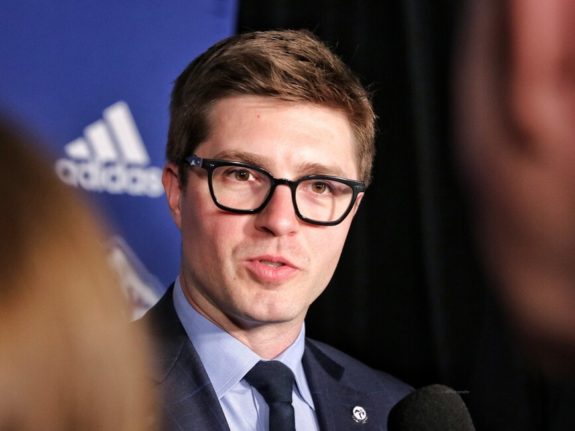
If Point, for instance, wants to stay with the Tampa Bay Lightning and contend for a Cup, there’s no way he’ll demand more money than teammates Steven Stamkos and Nikita Kucherov, who make under $10 million each.
Rantanen, who has scored 84 and 87 points respectively over the last two seasons, may have the best claim to a massive payday given his consistent production. It also doesn’t hurt that the Colorado Avalanche have $27 million in cap space, which the Finnish winger may try to exploit. But even then, Rantanen will be subject to both the current market and past comparables, which all peg him at well below $10 million given five or six-year term. And if he takes less than $10 million, after outscoring Marner in total goals and points over the last two seasons, Marner’s demands will lose all remaining credibility.
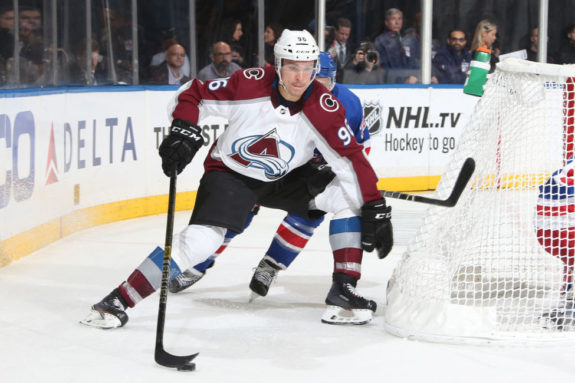
Dubas likely knows this. He’ll bide his time and let the pieces around him fall into place. At that point, when most of the other RFAs have signed, the picture will become clear. Marner and his camp will have no choice but to come back down to earth with their ask.
Dubas Can’t Repeat the Nylander Saga
Dubas must be patient with Marner, but for two major reasons, he can’t let negotiations bleed into the regular season.
For one, he won’t want to go through the same process that ruined William Nylander’s 2018-19 campaign. Unsigned until the Dec. 1 deadline, Nylander missed training camp and the first 28 games of the season. He was set up to fail from the start, and despite picking up the pace in January, Nylander’s 27 points in 54 games fell well below expectations. In his season-ending press conference, Dubas made it clear that he’s learned from that mistake. “I think the blame for the situation going that far has to go to me,” the 33-year old GM said. “I don’t think it set William (Nylander) up to have a good season.” If Dubas wants to ensure that Marner and the Maple Leafs hit the ground running next season, he’ll aim to get a deal done by training camp at latest.
The second point to consider is cap space. The Maple Leafs were able to sign Nylander so late into the season only because they had the space to accommodate his prorated cap hit of $10.277 million.
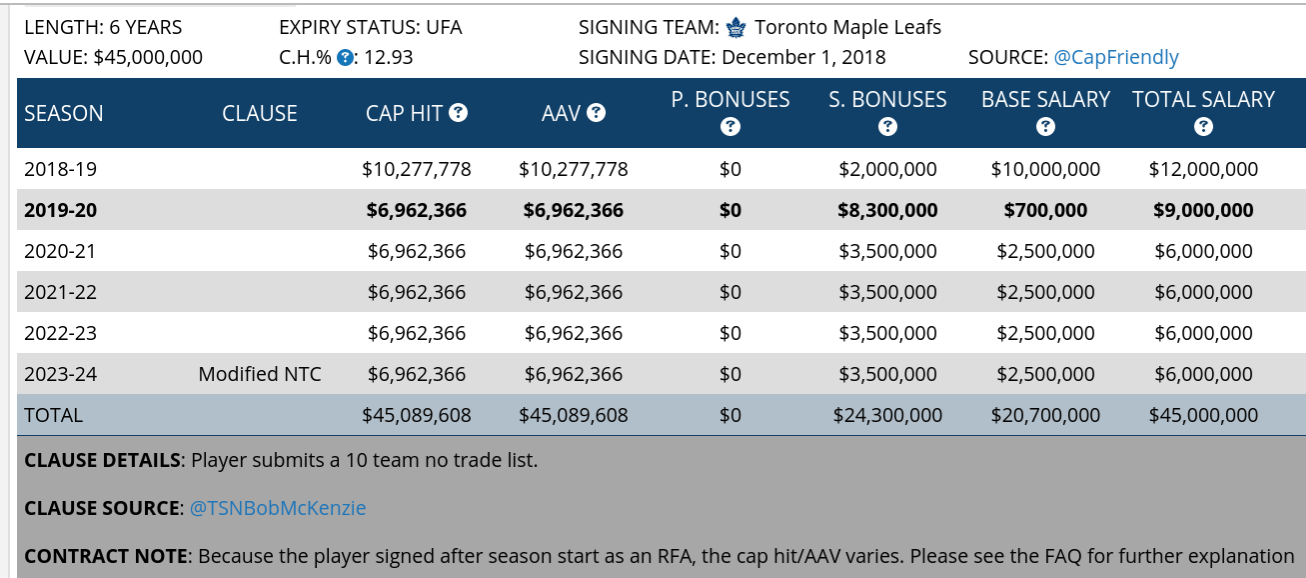
That was last season, when the young Maple Leafs didn’t have all their shiny new contracts on the books. This season, things are trickier. According to Cap Friendly, the Maple Leafs have just $3.765 million in cap space after extending Alexander Kerfoot and Cody Ceci. When you factor in Nathan Horton’s $5.3 million on LTIR, that number increases to $9 million. After that, the Maple Leafs can do a number of things, including placing the injured Zach Hyman or Travis Dermott on LTIR, or sending depth players down to the American Hockey League to clear some more space.
Regardless of how they approach it, the team should have just enough money to fit Marner’s contract – but only if he signs before the season begins. If he and the team can’t come to terms by then, his cap hit for the season will prorate and increase with every passing day. Dubas will want to avoid that at all costs.
Dubas’ Balancing Act
Over the past two weeks, Dubas has performed nothing short of wizardry: He’s cleared out two anchor contracts, upgraded a weak right side of his defence, and made several shrewd depth signings. After all of that, he’ll need to pull one more trick out of his hat in order to get Marner signed.
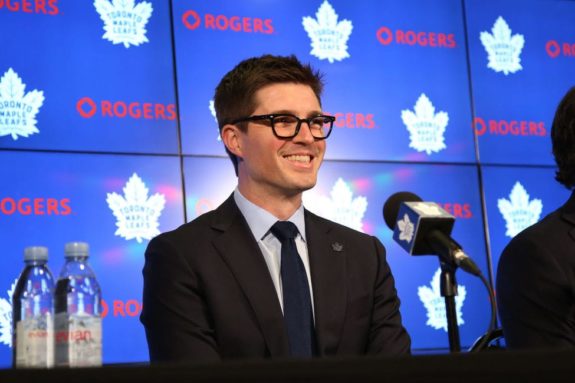
As explained, cap space is no longer the issue. Dubas’ task now will be to balance patience with swiftness. It’s in his best interest to wait for the RFA market to settle, but he also wants to get Marner signed as soon as possible. He can’t let another holdout occur, but he also can’t afford to overpay his star winger. And with each passing week, the possibility of a holdout looms just a little stronger. He’ll need to stare into the face of that threat without giving in.
Dubas has passed every test so far, but he’s not in the clear just yet.
Player stats from http://www.naturalstattrick.com/ and http://www.hockeydb.com/
Salary cap info from https://www.capfriendly.com/